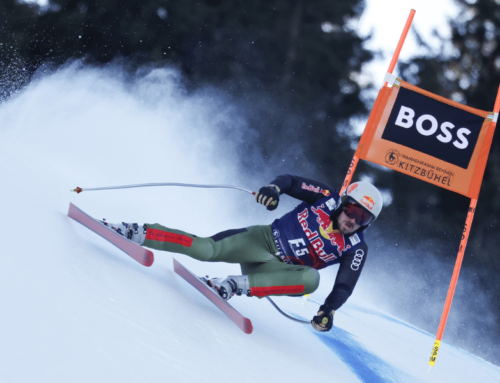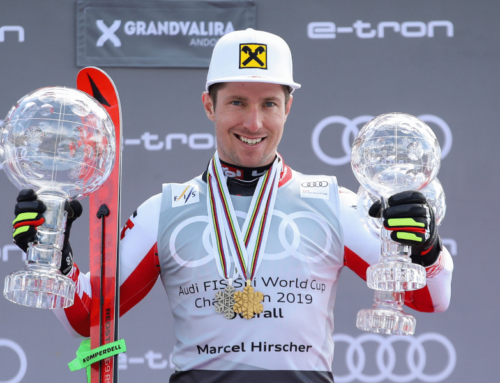Revealing the final resting place of the Kitzbuehel ‘Rookie Rock’ (plus a race preview)
Alan Lauba with the Rookie Rock. Photo: Doug Lewis

There is bygone tradition among the U.S. downhill team that underscores the reverence downhillers have long held for the Hahnenkamm race in Kitzbuehel, Austria and its fearsome track known as the Streif. An American downhiller was — and remained — a “rookie” until the day he crossed its finish line on race day. No exceptions. Olympic medals might garner global acclaim, but surviving the Streif garners respect. Winning it is to cement your name in alpine lore.

Every fall, the final U.S. team training camp concluded with a raucous affair known as Rookie Night. There were costumes, skits, and revelry that culminated with the awarding of the Rookie Rock. According to early recipient Doug Lewis, the tradition started around 1980, and for an entire year, one lucky rookie toted that honored rock around the world, everywhere he went. Then, when the burden of Kitzbuehel was lifted, the rock was passed on the following year … and on it went. Rocks were lost and replaced over the years, and in the post-9/11 travel era, rocks became particularly onerous travel companions.
Just the other day, I tracked down the rock’s last recipient, World Cup winner and serial Hahnenkamm finisher Marco Sullivan, to check on its whereabouts.
“It’s buried in my yard somewhere,” he said.
“Is there at least a cross marking its final resting place,” I asked.
“Unfortunately, no. I did not realize the gravity of my decision at the time. I just thought the thing was too damn heavy to actually lug around the world,” he said.

It was well known that Sullivan had more than a few extended visits with TSA. Though a tradition is now buried somewhere in the soils of Truckee, California, the reverence for this race is still very much at the surface.
By that old standard, Ryan Cochran-Siegel — ranked third in the World Cup downhill standings — is a rookie.
“Yeah, I came to Kitzbuehel in 2014, and there was no way I was ready. I just inspected to have a look,” he explained, referring to a year he was returning from injury. More injury followed, and it wasn’t until 2017 that he returned to race but only the super G and slalom. His first crack at the downhill was just last year, and he fell spectacularly mid-run. “So, I’ve still never raced to the bottom of the course,” he said.
Statistically, winning Kitzbuehel for first-time finishers is the longest of odds. It’s happened once since the beginning of the World Cup, in 1983. Bruno Kernen came from bib 29 to win with something of a weather-aided run. It was also one of the 12 times Kitzbuehel hosted two downhills on the same weekend. Kernen was seventh the following day and reached a downhill podium only one other time in his career. In five of those double downhills, the same skier won both days, suggesting that the Streif favors those familiar with its features.
This weekend will be the 13th time Kitzbuehel will host a double downhill. The first of two, set for Friday, will make up the canceled race in Wengen and will mark the 500th World Cup downhill ever contested. The second will take place Saturday, with a super G on Sunday.

Based on the opening training run, it seems RCS is poised to defy the odds. He was fastest, followed by teammates Travis Ganong in second and Jared Goldberg in fifth. If you look back at his rip of races and training runs — from Val Gardena to Bormio to now — it’s hard to deny that RCS is one of, if not, the fastest speed skiers in the world right now. On the one hand, he knows he has the ability to compete with the best on this hill, yet “each pass down a course can also change your mind as to what to do, and for me, if I try to be on a very exact line, it can be slow. … Right now, what’s working for me is that I’m just letting the course take me where it wants.” That takes confidence, which he’s found in his skiing. But he also knows the Streif is fraught with entirely unique elements, and “I need to respect those differences,” he said.

Another difference will be the field he and the Americans face. Downhill standings leader Aleksander Aamodt Kilde tore his ACL last week and is out for the season. Three-time Hahnenkamm winner Dominik Paris is racing but has looked under repair after tearing his ACL exactly one year ago. 2018 winner Thomas Dressen is still sidelined from his Nov. 26 hip surgery. That leaves three past winners in the field, Matthias Mayer (2020), Kjetil Jansrud (2015), and Hannes Reichelt (2014), along with one very hungry Beat Feuz. The Swiss racer has four podium finishes in Kitzbuehel, but no win, which is a Kitzbuehel record. For a skier with 10 World Cup wins, three downhill titles and a World Championship title, this is a glaring omission on his palmarès.
All told, these skiers average 10 years of experience on the famed Streif and showed more of their speed in the second training run on Thursday. But might 2021 be the year of the rookie?





















